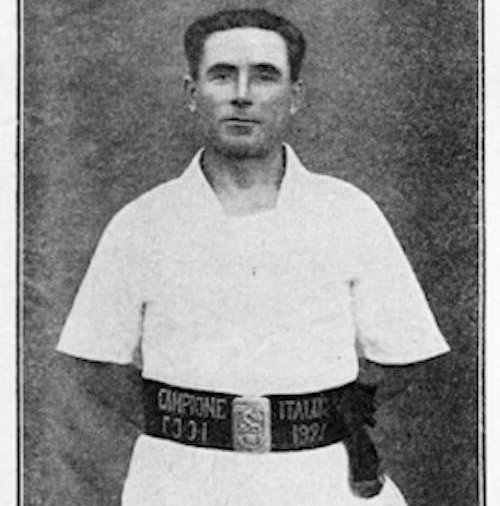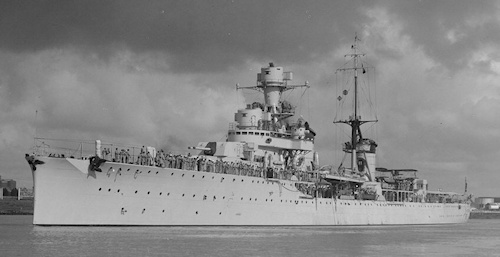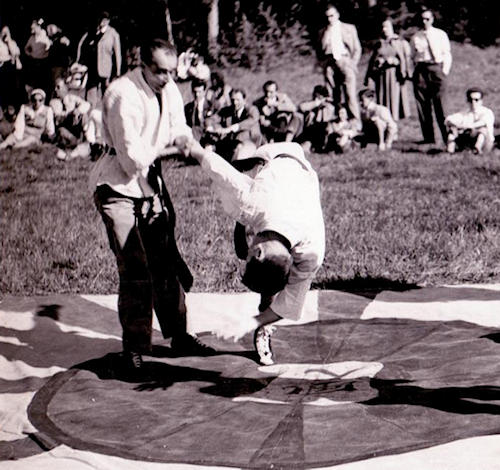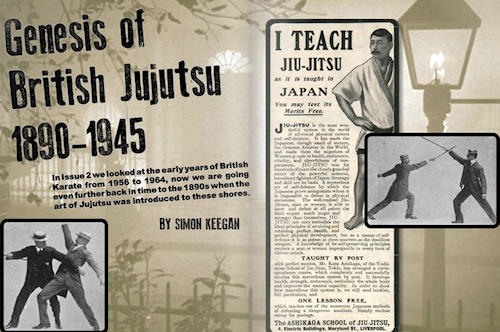It was the Italian sailors trained by the Japanese sailors present in China who encouraged the spread of jujitsu techniques, the oldest martial art.
We have the first information on this art only from the XNUMXth century even if the techniques handed down by the Samurai were already known in the XNUMXth century. This martial art called the “art of yielding” is associated with the concept of snow bending the sturdy branches of trees.
On these bases Aikido was born, which emphasizes the absorption of the opponent's inertia also present in jujitsu and, the most competitive, judo oriented instead on loading, projections and immobilizations.
The concept of jujitsu consists in intercepting the opponent's line of force to use it against him thanks to body movements, strikes, joint locks, strangulations and immobilizations. It cannot be excluded that at the beginning of the last century the term judo, which is easier to pronounce, also referred to jujitsu nicknamed "Japanese wrestling".
An understandable and long confusion
The history of the popularization of jujitsu and judo in Italy is truly intricate and absolutely uphill; Since it was a novelty, ignorance on the subject was also understandable.
 It came to life at the beginning of the last century by will of the then Minister of the Navy Carlo Mirabello, who ordered the vessel captain Carlo Maria Novellis to activate a jujitsu course on the cruiser Marco Polo stationed in China at the time. After some disappointments, the first satisfactions also arrived from the practice of these unknown martial movements. There were various names and teachers who gravitated towards judo and jujitsu, including Umberto Cristini, Pierino Zerella and Carlo Oletti (photo).
It came to life at the beginning of the last century by will of the then Minister of the Navy Carlo Mirabello, who ordered the vessel captain Carlo Maria Novellis to activate a jujitsu course on the cruiser Marco Polo stationed in China at the time. After some disappointments, the first satisfactions also arrived from the practice of these unknown martial movements. There were various names and teachers who gravitated towards judo and jujitsu, including Umberto Cristini, Pierino Zerella and Carlo Oletti (photo).
It should be noted, however, that the birth of judo should be attributed to the Japanese master Jigorō Kanō, a jujitsu expert, who had expropriated jujitsu of its most warlike component by favoring the techniques of unbalancing and throwing to the ground with the least effort. At the end of the 800th century, Jigorō Kanō gave life to the Kodokan, the temple, that is, the international home of judo which made this form of sporting wrestling famous throughout the world with thousands of schools. The Kodokan Goshin Jutsu introduced by the Kodokan in '56 is the only self-defense kata returned to the judo program.
The military among the first teachers
In Italy Carlo Oletti, chief gunner of the Royal Navy, embarked on a ship Vesuvio he played a fundamental role in the spread of judo and jujitsu. After having collected the teachings of the Japanese master Matsumura in 1905, upon his return to Italy in 1921, he began to train around a hundred officers and 1500 instructors at the Military School of Physical Education a Roma.
Gradually the martial art began to conquer more and more athletes and popularizers and probably jujitsu began to be separated from judo, capable of gaining much more popularity perhaps due to the competitive aspect.
The second evolution of jujitsu at a national level occurred several years later in 46 when, despite the aura of mystery surrounding the concepts of this Japanese art, another sailor decided to spread it to the select few of the Genoese population.

The non-commissioned officer “Gino Bianchi”
Biagio Bianchi, known by the diminutive of Gino o "U there" Bianchi is the founder of the Bianchi Method, a fairly widespread style and today included in FIJLKAM, the Italian Judo Wrestling Karate and Martial Arts Federation.
Gino Bianchi was born in Genoa in 1915 and, during the Second World War, he was embarked on a ship Diaz (photo) headed to the port of Tientsin in China. At that time she only had good athletic qualities for the practice of French boxing, which had come from beyond the Alps to her city. He is a rifleman in the Royal Navy and in the Italian base in China he begins to approach jujitsu thanks to his Japanese allies who are masters of the art of compliance.
Some curiosities about his history come from master Giancarlo Bagnulo, one of the most prestigious and authoritative names gravitating around the world of Jujitsu today, where he holds 7th dan, as well as being the author of numerous publications.
Beyond the oriental esotericism that surrounds the development of Japanese jujitsu, there is the curious story of Bianchi as a soldier and then master. Maestro Bianchi's military profile is little known, in fact it seems he did not like to confide in his past in the Navy. In fact, there would be some deletions and unclear notes on his registration sheet which suggest some connection with the espionage activity of the period. Even in the numerous video interviews his former students talk little about his experience in China, mentioning only learning this type of fight. They describe him as a stern but charismatic person, friendly in the gym and capable of being nice and understanding, but only outside of training. Despite his untimely death in 65, Bianchi managed to do at a national level what was missing in this discipline whose contents were previously unclear.

An Italian jujitsu
Having returned home in 46, Bianchi (photo) returned to civilian life as a school worker and decided to popularize jujitsu by dedicating an enormous amount of work to skimming and cataloging the techniques learned during training in China. He creates sketches on paper that have helped jujitsu to spread with images that are still used today.
He decides to remove what he considered superfluous including the Japanese terms: the mae geri becomes a kick or a kick, the mae ukemi, a somersault or spin. In short, he manages to transform a fighting art from the medieval Japanese fiefdom into a somewhat crude self-defense for the Western world. Evaluating the degree of difficulty and type, he inserted 31 techniques, which subsequently became 20, in each of the five alphabetical letters called sectors A, B, C, D and E.
The techniques represent a basic starting point for the opportunities for defensive actions, some appear excessively athletic, others a little too complex but, in those post-war times, the martial background taught by Bianchi made one safer from the risk of frequent robberies and pickpocketing, given poverty in the Ligurian capital.
A certain eccentricity of the master is curious; a student testifies that sometimes the training sessions were carried out to the rhythm of pop or rock music, perhaps to motivate the athletes more.
The masking
Maestro Bianchi's gym, set up in a former theater in via Salita di Famagosta in Genoa, was found above all by word of mouth. You knocked and he immediately understood from the opening of a trap door and chose who could enter his dojo. There were also women among the students and the environment and the objects took on some oriental connotations. The clothing was similar to that of Savate: boots, t-shirt and shorts; the keikoji arrived further ahead.
Master Bianchi also followed the most well-known judo matches with interest, but was keen not to be recognised, which is why he was skilled and imaginative in disguising himself. A characteristic that connects him with his "secret" past in the Royal Navy?

Spread to the West
The popularization of jujitsu and judo in Europe are linked to soldiers or civilians traveling to China or Japan at the beginning of the last century. In England, for example, it was EJ Harrison, journalist and scholar at the Kodokan, who brought the knowledge of judo to Manchester in the early 900s, while Barton Wright, an entrepreneur, is remembered as a pioneer of jujitsu on English soil.
Worth remembering is the English work for the diffusion of jujitsu, the World Ju-Jitsu Federation founded in '76 thanks to Soke Robert Clark who passed away in 2012.
Martial Europe is therefore the product of soldiers or adventurers of the early twentieth century and of individual abilities to spread art or a style. In reality, each student translates an art according to his own likeness and ability and, when there are many variations, there are the prerogatives of a new style.
The oldest methods of jujitsu included katanas - swords - even for knights, the training process was long and complex with different names based on the type of training. However, since jujitsu is technically quite vast and lacking in detail, many masters have been forced to also frequent judo and karate to probably erase the gaps left by jujitsu. Maybe Bianchi was also looking for this aspect? It is presumable that this is one of the reasons why jujitsu never took off completely compared to judo or karate. For more than twenty years, however, thanks to international exchanges, jujitsu has been experiencing a period of glory with integrated and complete programs and various specialties that have arisen from its bases: grappling-brazilian jj, that is, ground fighting and part of krav maga, the essence of self-defense born for the Israeli military.
Today among athletes who observe the historical aspect of martial arts it is not difficult to hear that: the flip side of the birth of interesting associations and federations that have spread martial arts is the loss of the martial spirit to make way for media and economic interests.
Also read: "Judo and the Navy: an ancient and prestigious history"
Photo: web












